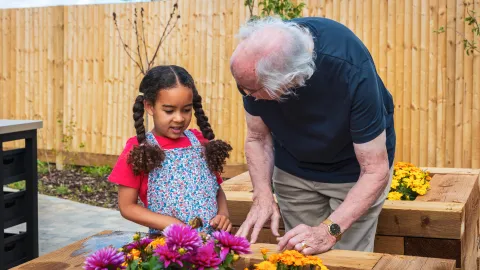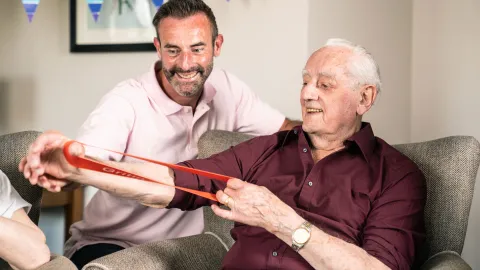
Best balance exercises for the elderly
Best Balance Exercises for the Elderly
Looking to be steadier on your feet? Research shows that balance exercises reduce the risks of falls for the elderly. According to AgeUK, falls represent the most frequent and serious type of accident in people ages 65 and over. Six elderly people fall every minute, equating to around 8,500 falls a day in the UK, highlighting the need to find ways and take actions to reduce the significantly high number. Balance exercises are one of the best things you can do in your day-to-day life to strengthen your bones. In this article, we’ll explore more about exercise for balance and how you can reduce the risk of falling.
Why is balance important as you get older?
Balance exercises prove tremendous benefits to a person’s overall health. As we get older, it is common for people to neglect exercise – the NHS Southampton team found that older people’s perception of their capability is influenced by the feeling of reduced strength and increased tiredness, reducing the likelihood of them participating in physical activity because of fear of injury or falling. However, it's important to make sure we are implementing exercises for balance in our daily lives – ageing means changes in muscle strength and joint flexibility, which can affect our ability to stay steady on our feet. When the ability to balance decreases, the likelihood of falling increases, never a great experience, sometimes resulting in anxiety or depression – people could develop an intense fear about moving around by themselves.
Balance is part of physical health
As we age, it’s natural to still want to maintain our independence for as long as possible. Leading an inactive lifestyle is definitely not the best for our bodies - you’ve probably heard of the term couch potato. Balance is a form of exercise, and improving your balance allows you to feel more stable, ensuring you are moving around safely in your daily life, while also helping you to retain your independence and optimising wellbeing.
Ageing can impact your balance
Ageing brings natural physical changes that affect balance. All three sensory systems that help maintain balance lead to balancing difficulties, such as dizziness or vertigo and increased risk of falls. Reflexes slow down, and muscle strength decreases, causing poor balance in the elderly that can often start out of nowhere, without an obvious reason as to why.
Being steadier on your feet and reducing the risk of falling
Falls are one of the leading causes in the UK, causing injuries that severely impair mobility or end lives, especially among the elderly or those with balance issues. Being steadier on your feet helps maintain control of your body during everyday activities, such as walking, standing, or being on uneven surfaces. The better the muscle mass, the more equipped and quicker people can react to changes in their environment, such as a slippery floor.
Four easy exercises for improving balance:
Here are some exercises that you can incorporate into your day-to-day life. Aim for around 20–30 minutes at least 3 times a week. Don’t worry if you struggle at first, usually, it gets better the more you practise. Here are some easy balance exercises for the elderly:
Sideways walking
Stand with your feet together with your knees a little bent. Slowly step sideways, moving one foot to the side first, then move your other foot so they are joined together. Avoid dropping your hips when stepping.
Heel to toe walking
Whilst you are standing upright, put your left heel on the floor directly in front of your right toe. Repeat on your right heel. Look forward at all times. If you’re feeling a bit unsteady, you can put your fingers against a wall for support.
One leg stands with wall support or a chair
Begin by standing by the wall, arms stretched forward and fingertips touching the wall.
Lift your right leg, hold your hips level. Keep a slight bend in your right leg. Slowly place your foot back onto the floor.
Standing and stepping
Stand facing a stable surface in front of you. Put your feet together side by side, facing the counter. Make sure there's room to step forward, both sides, and behind you. Picture a clock face laid out on the floor, with the 12, 3, 6 and 9 positions marked. Have someone call out different clock positions and step into the corresponding hour.
More advanced balance exercises for adults:
These exercises can be a bit more challenging to do. But over time, they will become a lot easier. Balance exercises at home include:
Sitting to standing
Firstly, make sure you’re sitting in a chair. Move your body to a standing position, without using your arms to pull you up. If you find this difficult to do, put a pad underneath you on the chair to help raise you. Then on to the seated position – slowly lower yourself all the way back, easing yourself into your seat and repeat.
Grapevine steps
This involves side-to-side movement, which many people tend not to do during exercise. You activate stabiliser muscles by doing this exercise.
Walk sideways by crossing one foot over the other. Begin by crossing your right foot over your left foot, then bring your left foot along so they are both joined.
Single leg balance
Start by standing with your feet hip-width apart, with your weight equally distributed over both legs. Place your hands on your hips. Lift your right leg off the floor and bend it back at the knee. Hold this position for up to 30 seconds. If you can’t hold good form for that long, repeat on the other side.
Kneeling four point balance exercises
Form a tabletop position by starting on all fours, hands directly under shoulders, and knees under hips. Slowly extend one arm forward, and the opposite leg backward, make sure that both are parallel to the floor. Hold this position for a few seconds, keep your body steady. Bring your arm and leg back to the starting position, and repeat on the other side.
Tai chi and Yoga for balance
Thaichi and yoga are both gentle dynamic exercises that have been practised for decades. Because these exercises incorporate a mix of exercise and meditation, they benefit not only the body but the brain too. TaiChi involves exercises that focus on postural orientation and enhance coordination and reflexes to centre and stabilise the body. While yoga strengthens and stabilises muscles for better stability and coordination – a mix of static and dynamic movements to challenge your balance in day-to-day life.
Safety tips for exercising
It can be easy to jump straight into exercising without considering other steps you need to take to arm yourself against injury. Here are some tips so you can avoid injuring yourself:
Keep a safe environment for doing your exercises
Consider your climate. Avoid exercising in hot, humid conditions as this can lead to serious overheating. Ideally, exercise in cooler temperatures, evening hours or in a place with air conditioning. Signs of overheating include headaches, dizziness, nausea, and faintness. If you do experience any of these symptoms, stop exercising immediately. Keep a clear space and use equipment that supports your safety, such as non-slip mats.
Using support for balance exercises
If you’re just starting, you may find balance exercises easier using support. It may also be the case that you’re just recovering from an injury or want to build up some confidence before doing the more advanced exercises. Consider using:
- Chairs
- Walls
- Yoga blocks
- Handrails
- Resistance bands
Listen to your body to avoid injury
Pay attention to your body. If something doesn’t feel right or feels painful, consider modifying your exercise and try a less intense version and see how it feels. Putting too much pressure on your body can cause injury, so make sure you are staying in tune with your body. You’ll notice that over a period of weeks or months of regular exercise, you’ll be better and may not feel as intense as when you started out.
Benefits of practising balance exercises
It may be daunting at first to start something you haven't done before. But practice makes perfect. Here are ways exercising for balance can benefit you:
- Improving mobility and independence.
- Boosting confidence and mental health.
- Enhancing overall fitness.
Here at Barchester, we have residential, nursing, dementia and respite care. Every day, we support people to live a meaningful and purposeful life for as long as possible. See what activities we have on offer.


